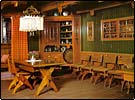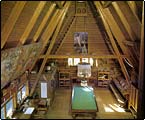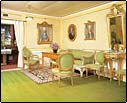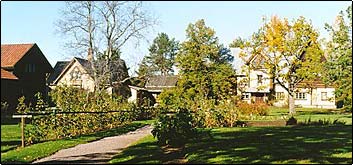 The Zorn Manor became after Emma Zorn's death in 1942 Government property and was accessible to the public. This house is one of the few remaining milieus from
the turn of the century that is maintained in its original condition. A time that had different conception about homines than what we have today.
In spite of the Zorn Manor's strongly imprintion of Zorn's subjective preferences, it is still a very good representative for the spirit of the time around 1900.
The combination in the garden of its curving paths and striking placed bronze statues indicates the ability of that times spirit to have the outdoor environment reflect the
homines. In front of the house the lawn is formed in a heart's shape and at its narrow end there is the fountain The Morning Bath. Behind the rosebushes lies the
Zorn Manor with its steep roofs and charming gables. It is easy to notice that this house was constructed over an extended period of time, judged by it's exterior, and that
an architect had not been involved in this process. It's an artist at work that has added room to room to form an artistic entirety.
 The essence of the Zorn Manor is an old Mora cottage from his parents home in Yvraden that he moved to the grounds close to the church in 1888. In 1895 he started to
enlarge the old cottage through extensions and additional storey. The rustic styled furniture is designed by Zorn. Next to the Zorn Manor he did build a house for his mother.
The essence of the Zorn Manor is an old Mora cottage from his parents home in Yvraden that he moved to the grounds close to the church in 1888. In 1895 he started to
enlarge the old cottage through extensions and additional storey. The rustic styled furniture is designed by Zorn. Next to the Zorn Manor he did build a house for his mother.
 The hospitality of the Zorns made it necessary to have several guestrooms at the Zorn Manor and on the ground floor there are two rooms for the guests and there is also
the dining room. Prince Eugen used to stay in one of the guest rooms and he has contributed with decoration in one of the rooms; with three paintings depicting winter
scenery. In the dining room is one of our countries biggest collection of silverware. Zorn did love everything handmade that skilled artisans produced, whether it was made
of silver or iron. The silverware's glared lustre in the Zorn Manor tells that this house's owner is a wealthy person and not a common peasant.
The hospitality of the Zorns made it necessary to have several guestrooms at the Zorn Manor and on the ground floor there are two rooms for the guests and there is also
the dining room. Prince Eugen used to stay in one of the guest rooms and he has contributed with decoration in one of the rooms; with three paintings depicting winter
scenery. In the dining room is one of our countries biggest collection of silverware. Zorn did love everything handmade that skilled artisans produced, whether it was made
of silver or iron. The silverware's glared lustre in the Zorn Manor tells that this house's owner is a wealthy person and not a common peasant.
 If you go upstairs you enter into the main room, a Viking hall of impressive size. This hall is made in a ingenious construction of logs that gives a big open floor area, not
common for timbered houses; and it was completed 1896. The details of the wooden ornaments are not an imitation of the Nordic style. Instead they are connected with
the decoration style at the turn of the century; with it's sharp and sometimes gentle contour. Parts of Zorn's collection are in the main room and among others the many
beautiful seat cushions for carriage from the eighteenth and nineteenth century or the tapestry that are covering the lower parts of the ceiling and the walls; the same
way it was done at the manorial estates both for its beauty and to protect against the cold. The classical antiquity is represented with bronze and terracotta statues and
statuettes, placed on the shelf above the veranda.
If you go upstairs you enter into the main room, a Viking hall of impressive size. This hall is made in a ingenious construction of logs that gives a big open floor area, not
common for timbered houses; and it was completed 1896. The details of the wooden ornaments are not an imitation of the Nordic style. Instead they are connected with
the decoration style at the turn of the century; with it's sharp and sometimes gentle contour. Parts of Zorn's collection are in the main room and among others the many
beautiful seat cushions for carriage from the eighteenth and nineteenth century or the tapestry that are covering the lower parts of the ceiling and the walls; the same
way it was done at the manorial estates both for its beauty and to protect against the cold. The classical antiquity is represented with bronze and terracotta statues and
statuettes, placed on the shelf above the veranda.
 Next to the main room is Emma Zorn's Green sitting- room furnished in a Gustavian style and even the paintings and their frames are from the same era. It is like being
transferred to a mansion from the eighteenth century, an unknown milieu in the upper Dalecarlia.
Next to the main room is Emma Zorn's Green sitting- room furnished in a Gustavian style and even the paintings and their frames are from the same era. It is like being
transferred to a mansion from the eighteenth century, an unknown milieu in the upper Dalecarlia.
Zorn's bedroom with furniture from the mid- nineteenth century on the same floor is strikingly spartan and somewhat small. On his writing- table there is a yellowing
photograph of the brewer Johann Leonard Zorn and on one of the walls hangs a watercolour of Carl Larsson's famous watercolour In the Mirror (I Spegeln).
The other rooms on the upper floor are Emma's library, reading- room and bedroom. The library is small but looks inspiring with its many fine spines and the inviting
place for reading by the window. The motifs on the doorpanels are of original paintings reasonably like the doorpanels on Sundborn.
One of Zorn's few pupils, Harriet Sundström, depicted the motif of horses and dogs in Emma's reading- room. Some of Anders Zorn's paintings hang in Emma's
bedroom and among others are a portrait of the artist and Emma portrayed from when they were secretly engaged in 1881.

|
 The essence of the Zorn Manor is an old Mora cottage from his parents home in Yvraden that he moved to the grounds close to the church in 1888. In 1895 he started to
enlarge the old cottage through extensions and additional storey. The rustic styled furniture is designed by Zorn. Next to the Zorn Manor he did build a house for his mother.
The essence of the Zorn Manor is an old Mora cottage from his parents home in Yvraden that he moved to the grounds close to the church in 1888. In 1895 he started to
enlarge the old cottage through extensions and additional storey. The rustic styled furniture is designed by Zorn. Next to the Zorn Manor he did build a house for his mother. The hospitality of the Zorns made it necessary to have several guestrooms at the Zorn Manor and on the ground floor there are two rooms for the guests and there is also
the dining room. Prince Eugen used to stay in one of the guest rooms and he has contributed with decoration in one of the rooms; with three paintings depicting winter
scenery. In the dining room is one of our countries biggest collection of silverware. Zorn did love everything handmade that skilled artisans produced, whether it was made
of silver or iron. The silverware's glared lustre in the Zorn Manor tells that this house's owner is a wealthy person and not a common peasant.
The hospitality of the Zorns made it necessary to have several guestrooms at the Zorn Manor and on the ground floor there are two rooms for the guests and there is also
the dining room. Prince Eugen used to stay in one of the guest rooms and he has contributed with decoration in one of the rooms; with three paintings depicting winter
scenery. In the dining room is one of our countries biggest collection of silverware. Zorn did love everything handmade that skilled artisans produced, whether it was made
of silver or iron. The silverware's glared lustre in the Zorn Manor tells that this house's owner is a wealthy person and not a common peasant. If you go upstairs you enter into the main room, a Viking hall of impressive size. This hall is made in a ingenious construction of logs that gives a big open floor area, not
common for timbered houses; and it was completed 1896. The details of the wooden ornaments are not an imitation of the Nordic style. Instead they are connected with
the decoration style at the turn of the century; with it's sharp and sometimes gentle contour. Parts of Zorn's collection are in the main room and among others the many
beautiful seat cushions for carriage from the eighteenth and nineteenth century or the tapestry that are covering the lower parts of the ceiling and the walls; the same
way it was done at the manorial estates both for its beauty and to protect against the cold. The classical antiquity is represented with bronze and terracotta statues and
statuettes, placed on the shelf above the veranda.
If you go upstairs you enter into the main room, a Viking hall of impressive size. This hall is made in a ingenious construction of logs that gives a big open floor area, not
common for timbered houses; and it was completed 1896. The details of the wooden ornaments are not an imitation of the Nordic style. Instead they are connected with
the decoration style at the turn of the century; with it's sharp and sometimes gentle contour. Parts of Zorn's collection are in the main room and among others the many
beautiful seat cushions for carriage from the eighteenth and nineteenth century or the tapestry that are covering the lower parts of the ceiling and the walls; the same
way it was done at the manorial estates both for its beauty and to protect against the cold. The classical antiquity is represented with bronze and terracotta statues and
statuettes, placed on the shelf above the veranda. Next to the main room is Emma Zorn's Green sitting- room furnished in a Gustavian style and even the paintings and their frames are from the same era. It is like being
transferred to a mansion from the eighteenth century, an unknown milieu in the upper Dalecarlia.
Next to the main room is Emma Zorn's Green sitting- room furnished in a Gustavian style and even the paintings and their frames are from the same era. It is like being
transferred to a mansion from the eighteenth century, an unknown milieu in the upper Dalecarlia.